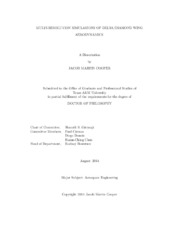| dc.description.abstract | This dissertation investigates high angle of attack delta wing flow at multiple resolutions of turbulence closure. The work is divided into four studies. The objectives of each study are: (i) to identify the limits of RANS modeling, (ii) explore the challenges of applying the PANS model to the delta wing flow, (iii) identify the appropriate resolution required to capture specific flow features, and (iv) determine the physical differences between sharp and round leading edge separation.
The outcomes from each of these studies are as follows. Steady-state RANS modeling is shown to be adequate for low and moderate angles of attack, except in regions near the point of primary vortex separation. At low Reynolds number the vortex structure on the forward portion of the wing is mostly laminar and must be fully resolved by the grid in order to capture the physics in the aft region. Also at low Reynolds numbers, it is shown that lower resolution simulations perform adequately in capturing important integral flow features such as pressure coefficient and the locations of the vortex separation and attachment lines. High resolution simulations of low Reynolds number flow do resolve more subtle flow features that do not significantly affect the aerodynamic characteristics. The principle advantages of high resolution simulations are most evident at high Reynolds numbers and high angles of attack. The relationship between scale resolution and observed flow features is established. The simulations establish the key flow feature differences between round and sharp leading edge wing at different length scales of motion. Features of interest are the intensity of the vortex structure, the levels of turbulence, surface streamline patterns, and surface pressure coefficient. Differences between the delta and diamond wing shapes are also identified. | en |


